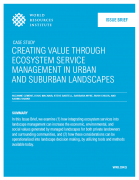Crear valor a través de la gestión del servicio ecosistémico en paisajes urbanos y suburbanos

Sinopsis
En este resumen de problema, examinamos (1) cómo la integración de los servicios ecosistémicos en la gestión del paisaje puede aumentar los valores económicos, ambientales y sociales generados por los paisajes gestionados tanto para los propietarios privados como para las comunidades circundantes, y (2) cómo estas consideraciones pueden ser operacionalizadas toma de decisiones sobre el paisaje, utilizando herramientas y métodos disponibles en la actualidad.
Resumen ejecutivo
Managed landscapes, such as residential lawns, golf courses, and parks, are deeply interconnected to a range of urban and suburban environmental, social, and economic issues. These links partly stem from landscapes’ provision of ecosystem services including stormwater retention, climate moderation, and improved air quality, which in turn affect populous communities’ health and well-being. These landscapes are often privately owned and intensively managed; in fact, landscape management is a $40 billion industry in the United States (Ghali et al. 2010). However, conventional landscaping business practices and sustainability initiatives rarely consider the full range of ecosystem services potentially derived from managed landscapes. As a result, much of the environmental, social, and economic value of these landscapes remains untapped and unmanaged.
New tools and methods for measuring and economically valuing ecosystem services are emerging. These methods can be applied to managed landscapes to guide a range of design and management decisions, including which vegetative covers and management practices to use to produce different environmental outcomes. Ecosystem service assessment and valuation are already being applied in agriculture and forestry sectors.
Creating Value through Ecosystem Service Management in Urban and Suburban Landscapes, a joint effort by the World Resources Institute and Cardno ENTRIX, describes the ecosystem services approach and how it relates to managed landscapes. It reviews the economic, environmental, and social benefits derived from managed landscapes with a focus on seven ecosystem services: aesthetic and recreation opportunities, water quality, air quality, carbon sequestration, local climate control, water retention, and soil retention. These services can be quantified and economically valued using existing methods.
Finally, the brief proposes a conceptual ecosystem service framework for managed landscapes, to aid in operationalizing and eventually standardizing these considerations into landscape management. A recommended next step is for relevant stakeholders to test this framework on managed landscapes, working toward an elaborated standard framework to evaluate managed landscapes and the ecosystem services they provide. Toward this goal, this Issue Brief is accompanied by a more detailed white paper, A Framework to Quantify and Value Turfgrass Ecosystem Services (MacNair et al. 2013).